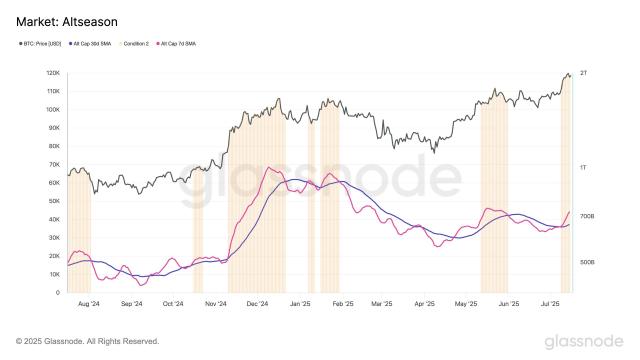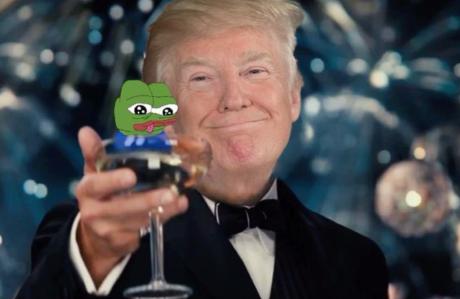Written by Daii
In the world of cryptocurrency, the distance between "evangelists" and "harvesters" is often only separated by an almost invisible line.
This line is called "trust".
The evangelist we are going to talk about today is Mike Novogratz, a former Goldman Sachs partner, New York Fed consultant, and now the founder and CEO of Galaxy Digital. With unparalleled passion and firm belief, he has spread the vision of cryptocurrency to the world in various ways, becoming an indispensable voice in the industry.
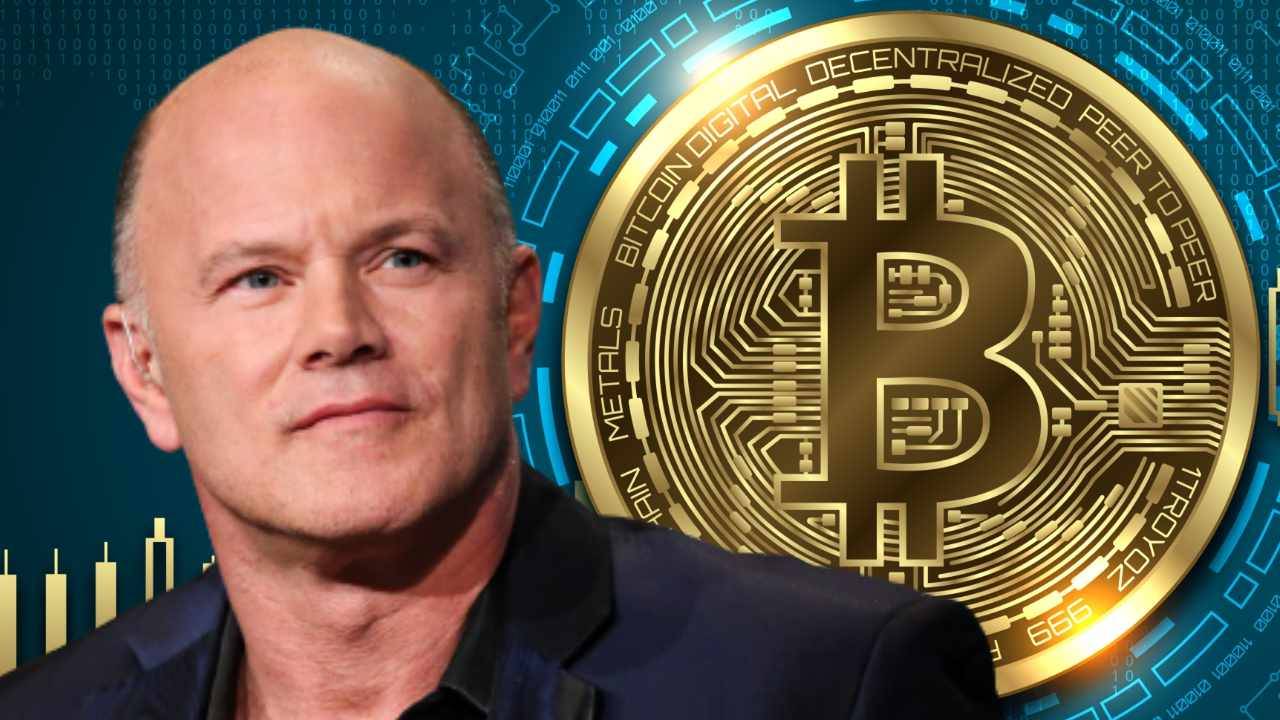
Galaxy Digital, known as "the institution that knows cryptocurrencies best on Wall Street", not only manages billions of dollars in assets, but also enjoys a high reputation in the entire crypto industry. Countless investors have invested their own funds without hesitation because of their trust in Novogratz and Galaxy, dreaming of seizing the opportunities of the times and becoming one of the lucky ones.
However, sometimes "trust" becomes a fatal trap.
The story we are going to tell today was originally supposed to be shared with you last week, but the sudden tariff war between China and the United States forced us to temporarily insert an episode on the topic of the fragmentation of the US dollar hegemony and the rise of decentralized stablecoins. Although those grand narratives are related to the global pattern, for ordinary investors, today's story may be more important.
If you have ever lost all your money in Luna, don’t blame yourself too much. It’s not because you lack judgment, nor is it that Luna was doomed to fail from the beginning. It’s because you didn’t know that the person who encouraged you to “stick to your faith” every day had already quietly cleared out his chips when you bought at a high price.
What you need to be more vigilant about is that such a harvesting drama has never ended, it just changes the scene and actors. Behind almost every "belief carnival", there are countless retail investors paying for the shipping strategy accurately calculated by a small group of people.
Maybe you will be angry and even try to seek justice. But the cruel truth is: unless you can clearly prove the fraudulent intentions of these KOLs (Key Opinion Leaders) or institutions, it is almost impossible to recover the losses you have suffered.
Because the legal threshold for defining fraud is extremely high, you must provide sufficient evidence to prove that the other party not only knows that the project involves huge risks or false information, but also has clear malicious intent and deliberately misleads you into the market to facilitate their cashing out at a high level.
However, reality is always more complicated than theory. KOLs shrewdly avoid the red line of the law. What they say is always ambiguous, such as "optimistic", "huge potential", "represents only personal opinions and does not constitute investment advice". As long as their language is vague enough and their shipping actions are covert enough, it is almost impossible to convict them.
This is the thickest fig leaf for KOL-style harvesting—the motives are difficult to prove and the subjectivity is unfounded.
But you must be curious: If it is so difficult to be discovered, why did Galaxy CEO Mike Novogratz eventually "fail"?
At this point, we must mention a key figure - the New York Attorney General, and a special law - the Martin Act. It is precisely because of this law, or more precisely, the existence of the law, that the New York Attorney General can launch an investigation without proving a clear intention to defraud, and uncover the sophisticated scam hidden behind "belief". Galaxy is the first to be caught, but it will never be the last. We have had a very detailed introduction to the Martin Act. This law, which once fined the Trump Group $450 million, is now targeting the crypto. English version
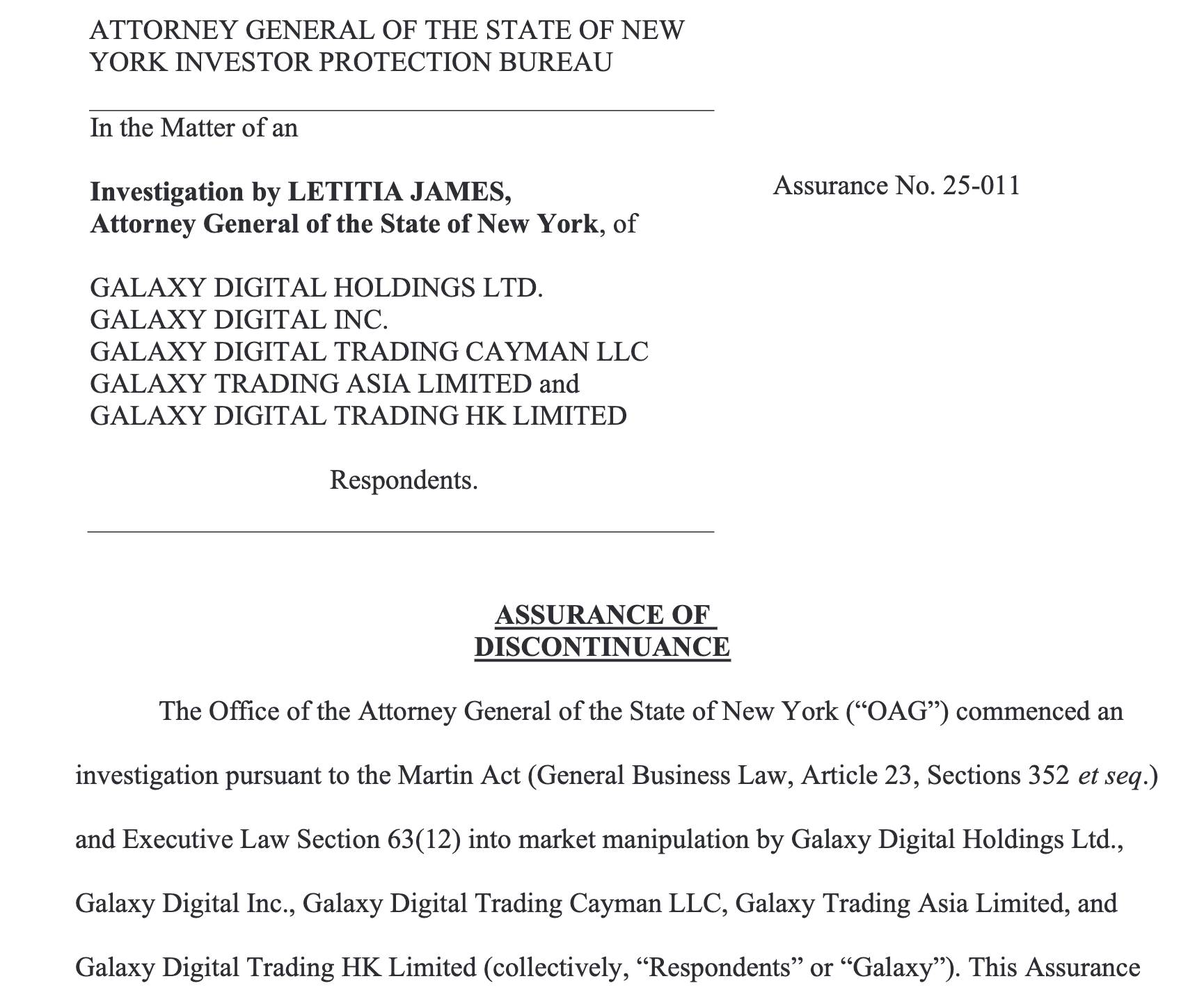
After reading this 44-page document from the New York State Attorney General's Office, I have to sigh: If there were no restrictions on the so-called "most ruthless securities law in the United States", there would be no in-depth investigation by the New York State Attorney General. We may never know: Behind the bursting of the $40 billion bubble of Luna, there is such a sophisticated and brilliant institutional selling script.
I hope that today’s article is not just a financial story with ups and downs for you, but also a warning to keep a distance from KOLs and institutions.
Next, let’s first figure out how Galaxy and LUNA came together?
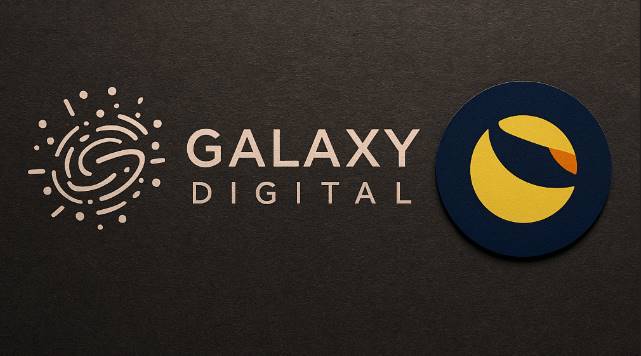
1. How did Galaxy and Luna become connected?
Before we start telling this thrilling "shipping story", we must first clarify the origin of the protagonist - Galaxy.
1.1 Who is Galaxy?
Galaxy Digital, whose full name is Galaxy Digital Holdings Ltd., is registered in the Cayman Islands and has its business headquarters in New York. It was founded by a tycoon who has been working on Wall Street for decades: Mike Novogratz.
Who is he? A former partner of Goldman Sachs, he once served as a member of the Investment Advisory Committee of the Federal Reserve Bank of New York. He started to get involved in Bitcoin as early as 2013 and was one of the earliest "institutional believers" who publicly supported crypto assets. If you have read about the "future of Bitcoin" on CNBC, Bloomberg, and Financial Times, his name is likely to be mentioned.
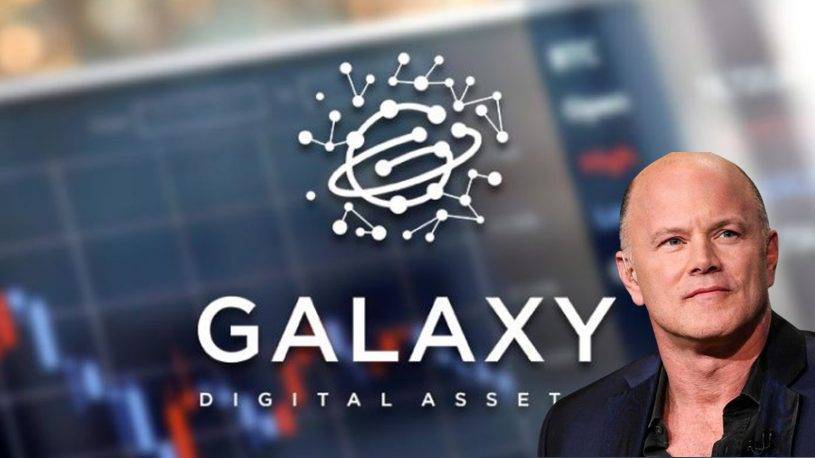
In 2018, he founded Galaxy, which manages more than $5 billion in assets and has 123 subsidiaries around the world, covering market making, venture capital, trading, custody, research... It is almost a "Morgan Stanley of the crypto world."
In other words, if the industry needs a representative who is "most like Wall Street", it must be Galaxy. Obviously, Galaxy is the best partner for Luna, no doubt about it.
1.2 What is Luna?
Now let’s get to know the other protagonist of the story: Luna.
Luna is a cryptocurrency issued by Terraform Labs in 2018. The project was founded by Korean Do Kwon and registered in Singapore. Its core goal is to create a dual-currency system of "algorithmic stablecoin + main currency".
This ecosystem consists of several parts:
Terra blockchain: the underlying ledger where transactions occur;
Luna: The platform’s native token, used for governance, staking, and regulating stablecoin supply and demand;
TerraUSD (UST) and TerraKRW: so-called “stablecoins” that claim to be pegged to the US dollar and the Korean won;
CHAI: A Korean payment app that promotes “real-world use cases”.

Sounds cool, right? But the problem is: its "stabilization mechanism" is completely dependent on market behavior. Once UST is decoupled, Luna will fall into a "death spiral". UST is essentially an algorithmic stablecoin, and there has been no successful case so far. The previous issue of "Tariffs are Knives, Currency is Shield" has a more detailed analysis and introduction of stablecoins, you can go and learn about it.
You need to pay attention to the payment system CHAI mentioned above, which is somewhat similar to China's Alipay and the United States' PayPal. Do Kwon is the co-founder of CHAI. It is precisely because of the existence of this real-world connection point that Galaxy has important materials to promote Luna.
To put it bluntly: Luna is an innovative financial project that has the potential to succeed, but the possibility of failure is greater. However, Do Kwon thinks this story is exciting enough, and he needs to find a "Western spokesperson" to help him tell this story to Americans.
1.3 "Connection": The transaction script of Western endorsements
By 2020, Do Kwon realized that if he wanted Luna to become popular, it would take more than just Korean speculators and white papers. He wanted to increase his popularity in the Western market, so he needed a "credible" brand endorsement. So they found Galaxy.
In August 2020, Terraform extended an olive branch to Galaxy and made a deal proposal: Terraform hopes that Galaxy can be their advocate. As long as Galaxy's CEO is willing to speak out and promote Luna, we can give you better investment terms.
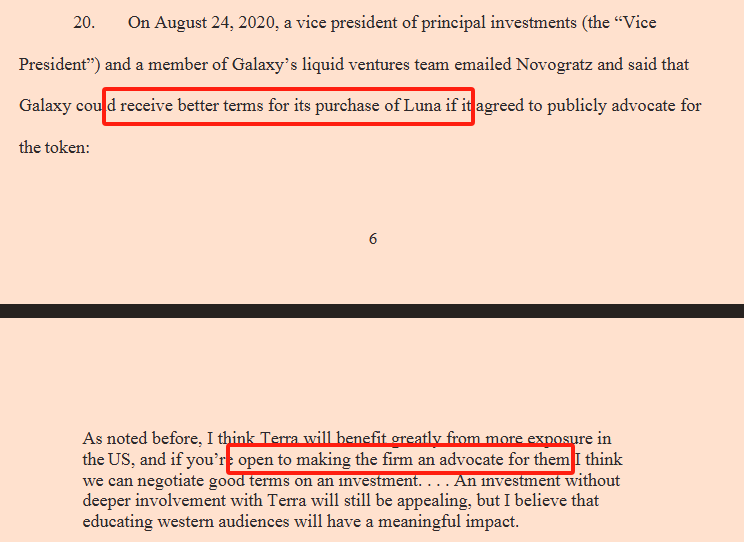
Galaxy immediately started discussing the matter. They had long noticed Terraform's technology and realized that there was a huge capital demand behind this project. On October 27, 2020, the two parties finally finalized the deal, as shown below:

Galaxy invested $4 million;
Purchase 18.51 million Luna at a discounted price of $0.22 per Luna;
1/12 is unlocked every month and can be sold at any time.
Note: The market price at that time was $0.31, Galaxy got a 30% discount, and was not forced to lock up. This is not a "good price from heaven", this is the trading right they got in exchange for endorsements, publicity, and platforms.
The hidden rule behind this is: as long as you are willing to "say something nice", we will let you "unlock it quickly". Galaxy accepted all of this with a smile, and even wrote in an internal memo that Terraform is not well-known in the US market, and it depends on us to promote it so that people can believe that its economic activities are real. See the text in the red box in the figure below for details.
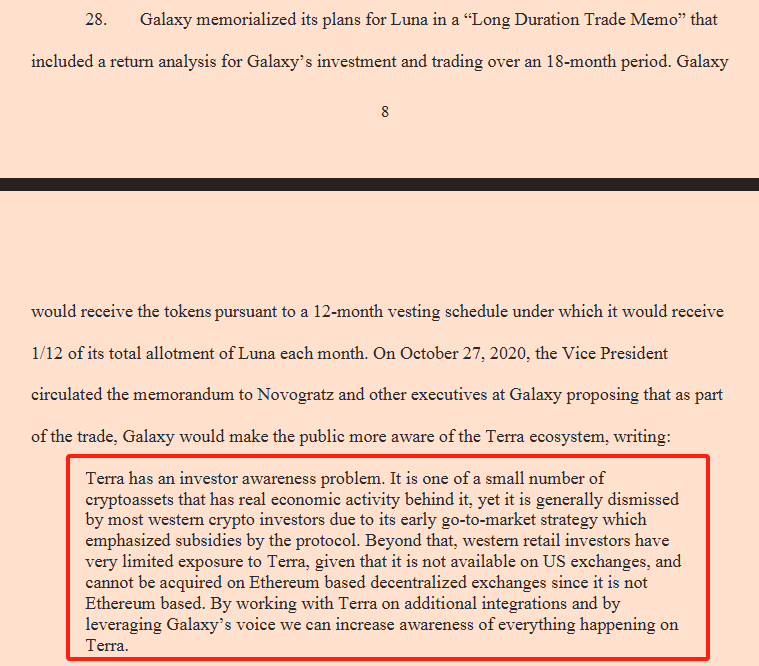
So, starting from November 2020, Galaxy began to systematically "mention" Luna in podcasts, tweets, and interviews, and the price began to rise, and the trading volume expanded rapidly. This rhythm lasted for a whole year.
1.4 Summary: In a desperate struggle for money
The reason why Galaxy and Luna came together was not because of "ideas in common" or "technological leadership", but a thorough "exchange of interests":
Terraform offers discounts and unlocking perks;
Galaxy provides traffic, trust and packaging;
The two parties reached an implicit consensus: you are responsible for setting up the game, I am responsible for shill, and no one can reveal it.
Judging from the results, this "cooperation" was very successful:
Luna’s price rose from $0.31 to a high of $119;
Galaxy made profits exceeding hundreds of millions of dollars;
Retail investors took over at high prices and then entered a "death spiral".
In essence, this is a typical "structured selling script", but it does not violate the traditional securities law provisions, which is why many KOLs have cried foul. But in the face of the Martin Act, this is an outright fraud, because your words and deeds are inconsistent, pushing up prices while selling, this is market manipulation, which is illegal.
It is for this reason that Galaxy is willing to pay a settlement of $200 million in exchange for a "suspension guarantee" from the New York Attorney General's investigation, see the figure below.
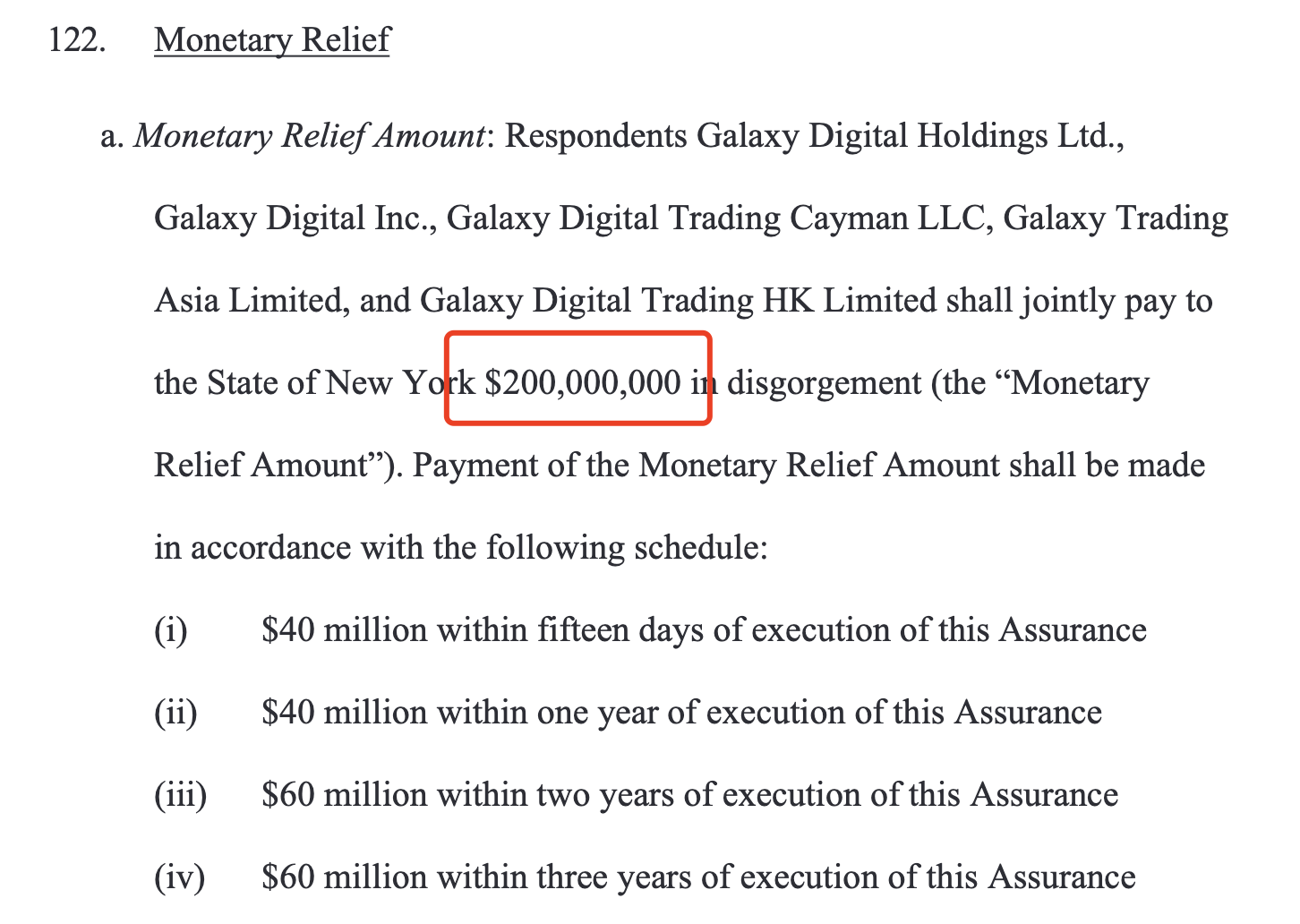
In order to analyze Galaxy's method of pumping up shipments, I carefully read this 44-page document, and I will break it down for you one by one below.
2. How did Galaxy increase shipments?
Next, we will reveal how Galaxy shouted "belief" while accurately selling chips. Before disassembling this sad story in depth, I must objectively say a few fair words for Galaxy and Mike Novogratz, so as not to make you mistakenly think that Novogratz is just a "shameless person."
You may not know that as early as 2013, when the entire Wall Street was still collectively laughing at Bitcoin, Novogratz had already invested real money in it. Not only did he publicly buy Bitcoin, he also publicly expressed his optimism about crypto assets in mainstream financial media and supported this "financial revolution." More precisely, he predicted in 2013 that the price of Bitcoin would rise significantly, and in 2014 he invested in Ethereum, which was still in its infancy, through crowdfunding. He once said that 20% of his net worth was invested in Bitcoin and Ethereum, which was shocking in the conservative and cautious Wall Street circle at the time.
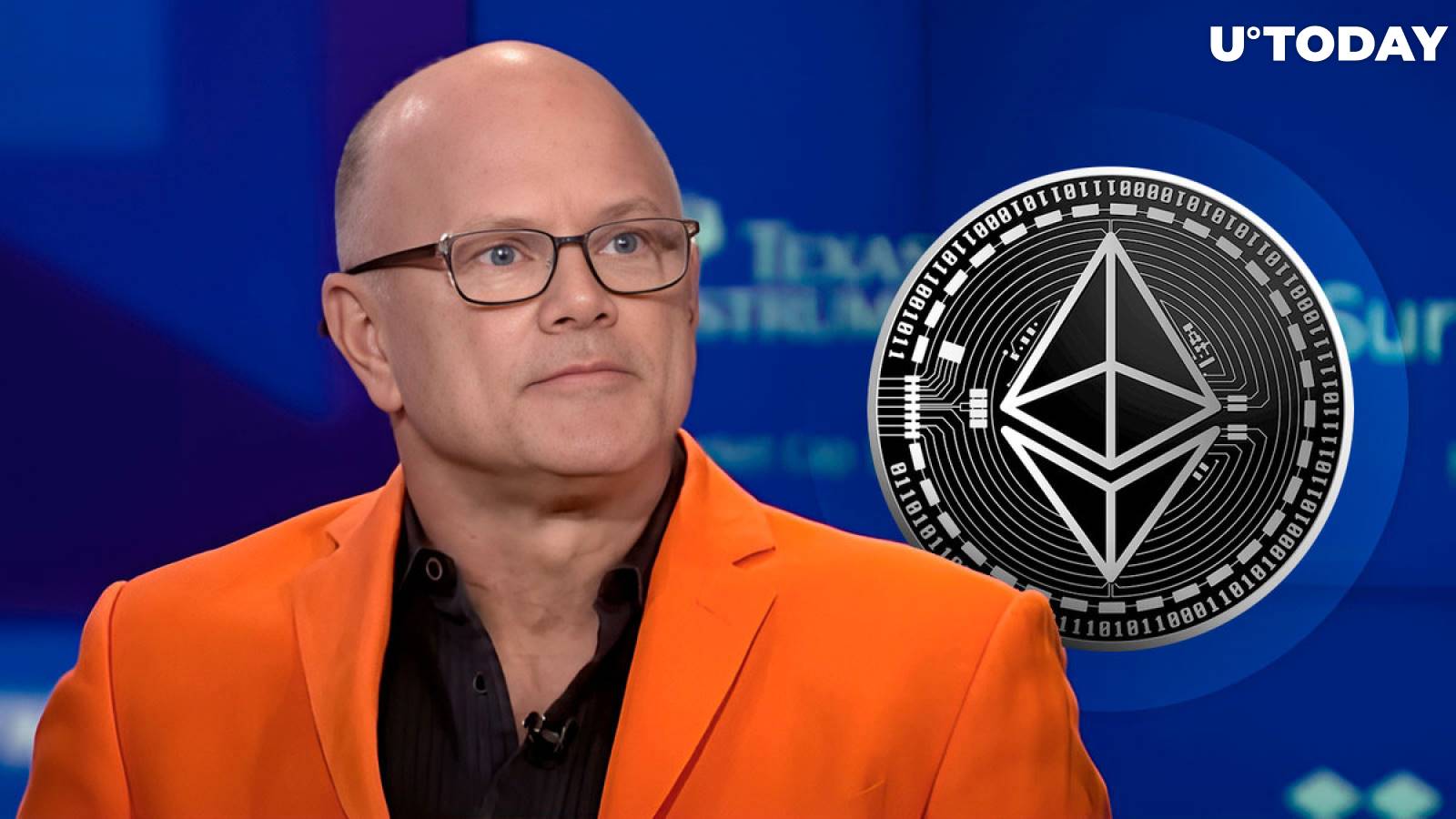
As of 2024, Galaxy has publicly invested in 72 projects, including Polygon, Bitfarms, Celestia and other top crypto projects, with a cumulative investment of billions of dollars. Although Circle (USDC issuer) and Bitwise (crypto ETF issuer) have not directly disclosed Galaxy's investment records, Galaxy's active participation in ecological cooperation and consulting services still contributes significantly to the overall ecological construction of the crypto industry.
In other words, the fact that you can buy coins on Coinbase, transfer money with USDC stablecoins, and the Ethereum ETF has been approved today is indeed inseparable from the contribution of Galaxy in the early stage of market uncertainty. Galaxy is not the so-called "harvesting foreign capital", but a "old-school player" who has truly accompanied the industry's growth for a long time.
This is exactly why the "shipping incident" we are going to reveal today is so sad. Because, with Galaxy's long-term accumulated market reputation and resource advantages, they could have chosen a more transparent and legal way to make profits, rather than falling into the quagmire of "gray shipments" that is now criticized.
Unfortunately, Galaxy eventually couldn't resist the temptation. They fell into the trap they designed and chose such a clever but unethical way to make a profit - pumping up shipments.
Next, I will explain in detail how Galaxy manipulated market sentiment step by step and completed the shipment and cashing out with superb techniques.
2.1 A trial run: the first attempt at "shill to ship"
The story begins at the end of 2020.
The agreement signed by Galaxy unlocks 1/12 of Luna every month. As a Wall Street veteran, Novogratz naturally understands that the most effective way to make quick money is to "sell while selling."
On November 11, 2020, before Galaxy received the first batch of Luna, Novogratz couldn't wait to start promoting Luna. On the well-known podcast Nugget's News, he told listeners that he recently bought a bunch of Luna, which is a Korean payment company, a bit like a credit card company, and users can get discounts with it. See the picture below for details. In fact, this is not true at all, and Luna is not actually used.
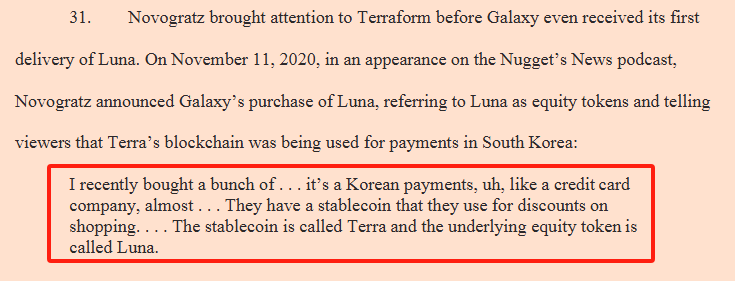
A few days later, on November 14, a netizen asked on Twitter: "Dude, can you recommend a coin?" Novogratz immediately replied: "$luna." See the picture below.
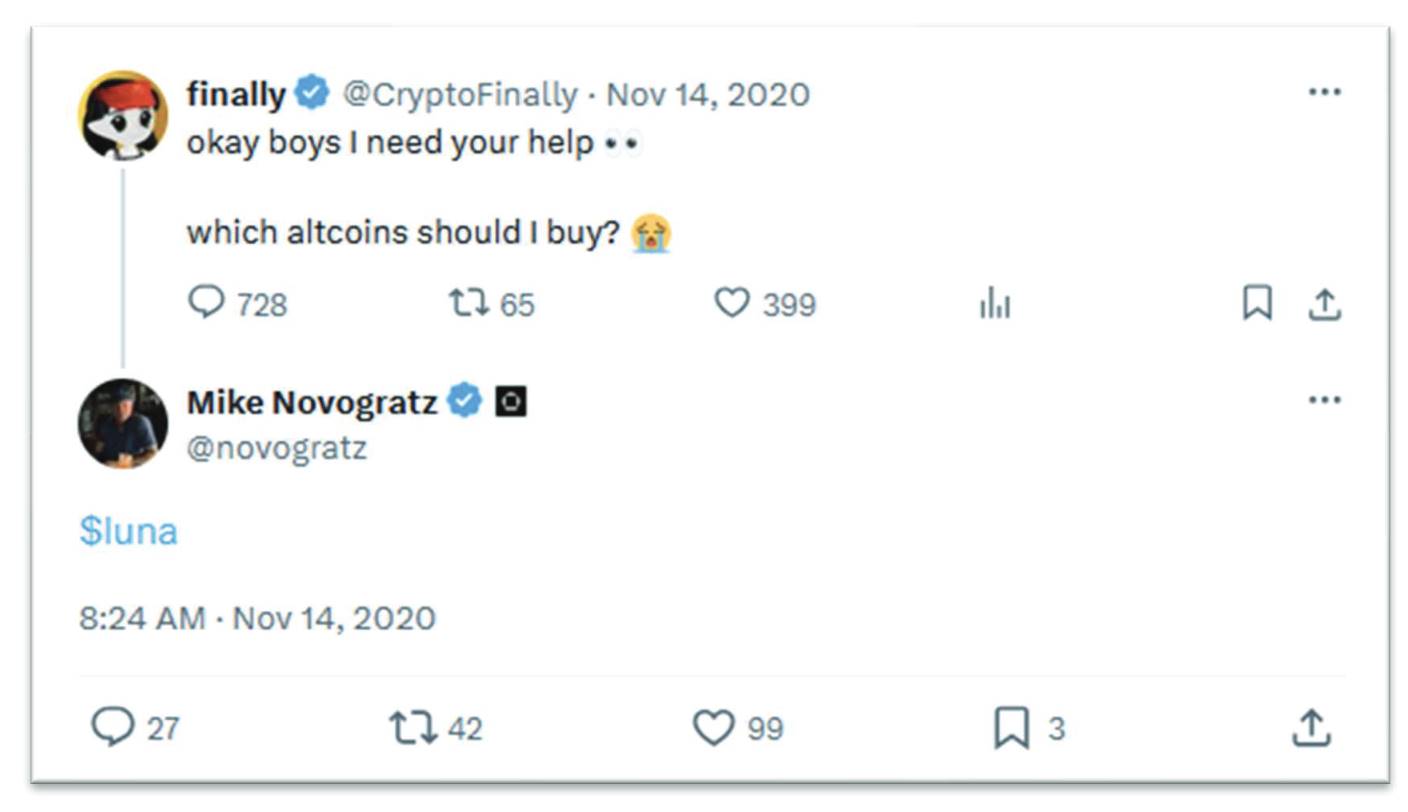
In December, Novogratz tweeted: South Korea’s payment app Chai already has 80,000 active users per day, $LUNA has great potential! As a result, Luna’s daily transaction volume instantly jumped from $27.5 million to $69 million that day, and the market enthusiasm was ignited all of a sudden.
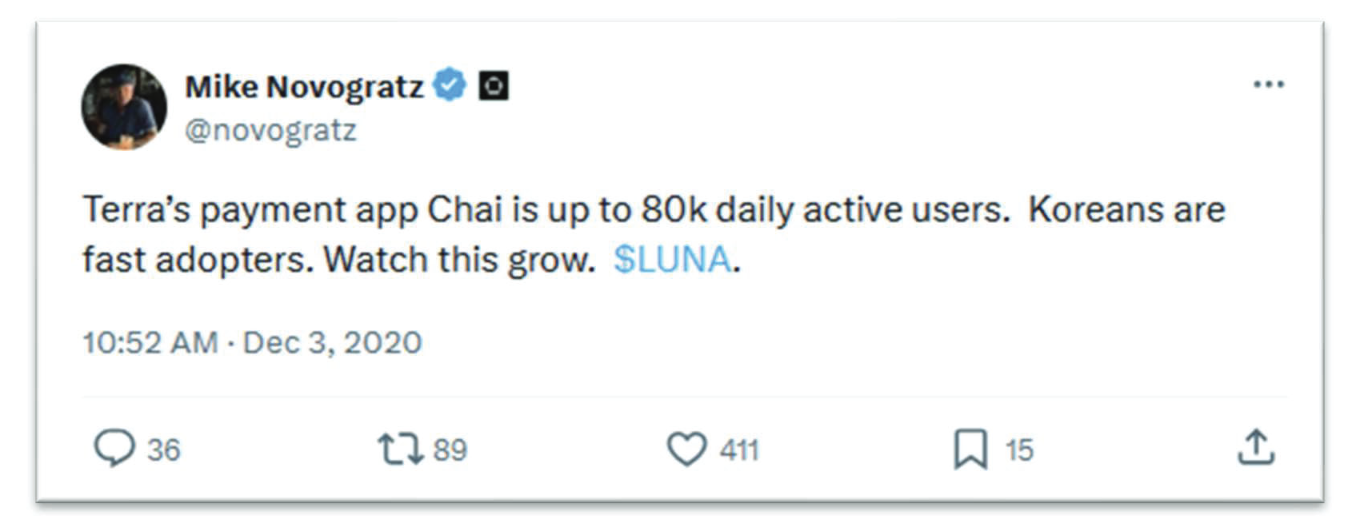
On the same day, Galaxy received the first batch of unlocked Luna: more than 1.54 million pieces. However, this "respectable" Wall Street veteran told the internal team: Don't rush to sell. His rule is that he will not ship within 3 days after sending a positive tweet.
Two weeks later, on December 16 and 17, Galaxy sold all of the Luna at a price of $0.50 to $0.52 per coin, marking a perfect end to the first "shill shipment" campaign.
Back to the "no shipment within 3 days of raising the price", it sounds very particular, right? However, even this self-imposed rule is not well implemented. In the face of the flood of money, everything seems so vulnerable.
2.2 Battle to recover investment: Bloomberg’s help
Galaxy is obviously addicted to "selling shill". But to quickly realize profitability, they need a bigger stage. This time, they chose the mainstream financial media - Bloomberg.
In January 2021, Galaxy contacted Bloomberg and provided a press release containing false data, claiming:
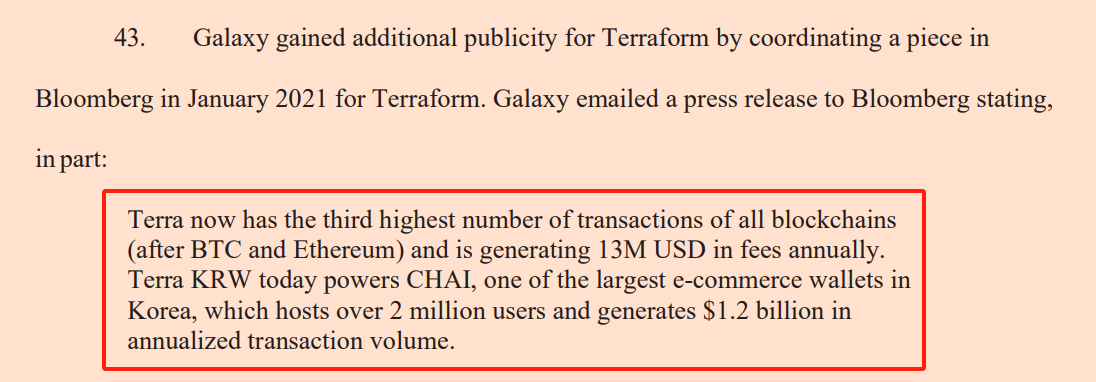
Terra now has the third highest number of transactions of all blockchains (after BTC and Ethereum) and is generating 13M USD in fees annually. Terra KRW today powers CHAI, one of the largest e-commerce wallets in Korea, which hosts over 2 million users and generates $1.2 billion in annualized transaction volume.
Translation: Terra has become the world's third largest blockchain by transaction volume, second only to Bitcoin and Ethereum, generating $13 million in transaction fees each year. Terra's Korean won stablecoin (TerraKRW) supports CHAI, one of South Korea's largest e-commerce wallets, with 2 million users and an annual transaction volume of $1.2 billion.
The truth is that Chai's transactions did not use the Terra blockchain at all, and all payments were still made in Korean won, which had nothing to do with Luna and TerraKRW. So why did Galaxy and Terra have to fake it and use Chai as a prop? Because without Chai as a backing, the story would have no imagination.
On January 26, 2021, Bloomberg published a blockbuster report titled "Novogratz Invests in Crypto Startup Serving Millions in Korea", and the price of Luna immediately soared from US$0.89 to US$1.23.
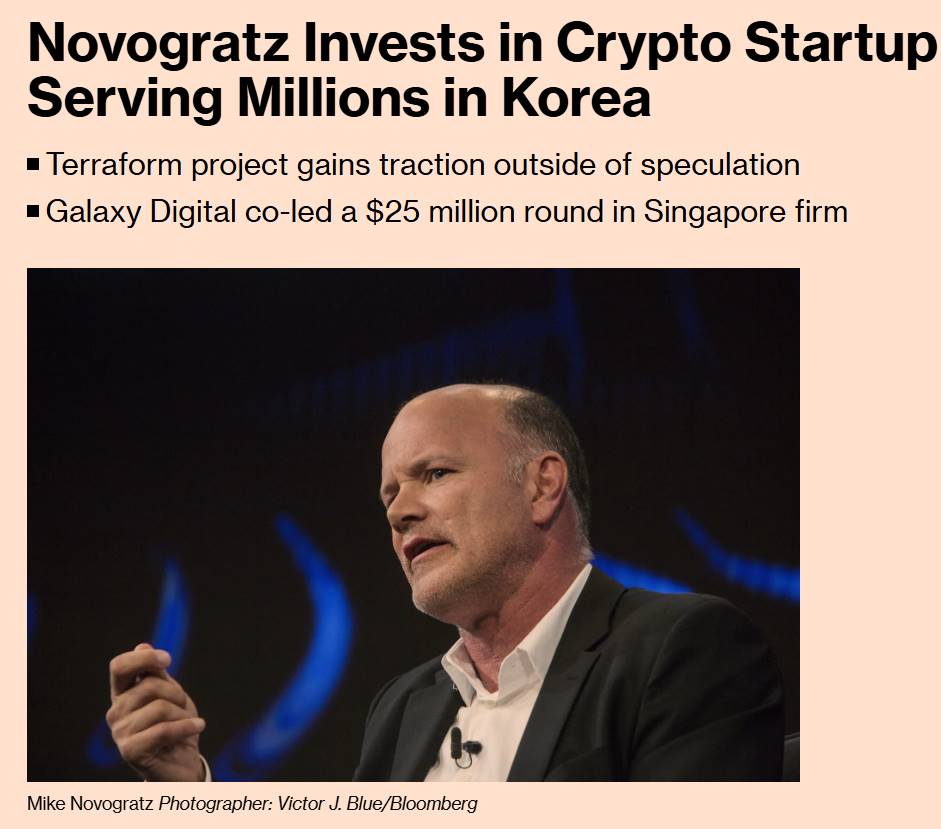
CoinTelegraph reported the news with the title "LUNA doubles in price after $25 million investment by Galaxy Digital", which triggered a frenzy in the market.
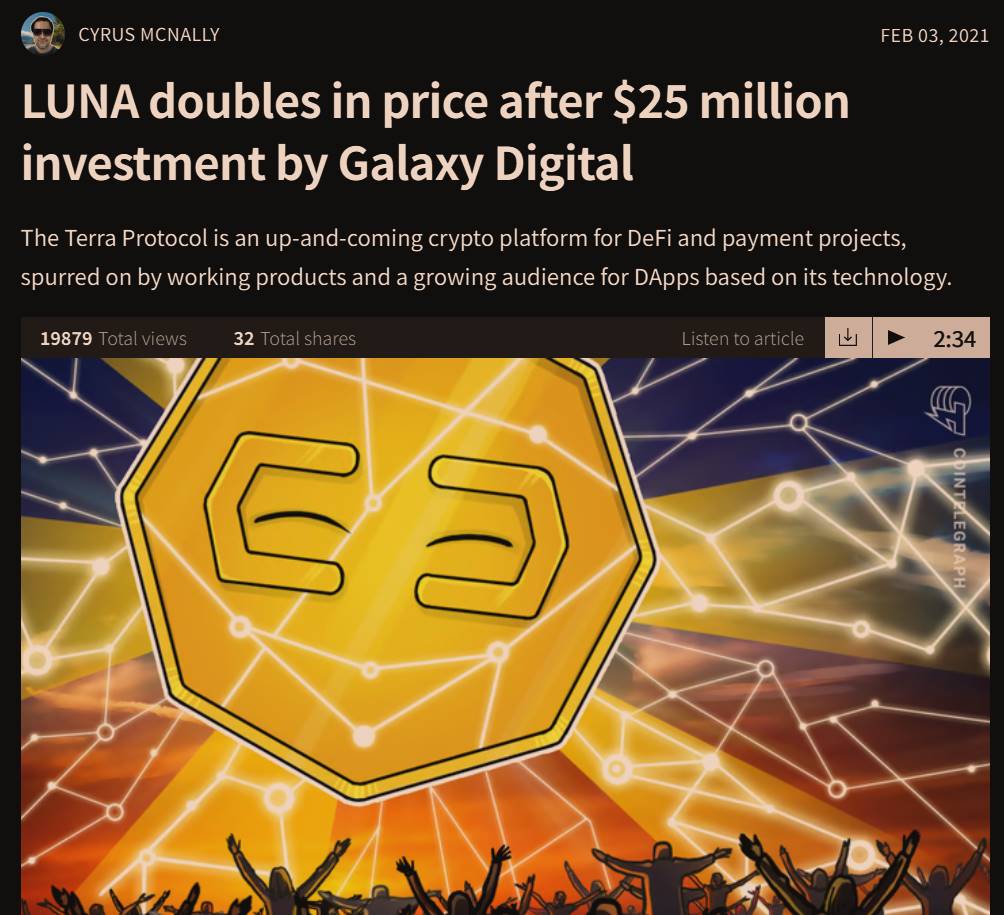
Just a few days after Bloomberg's report, Galaxy shipped again, selling more than 1.54 million Lunas on January 30, 2021, at a price of $1.47 per Luna. At this point, Galaxy had successfully recovered its initial investment of $4 million.
This battle was fought cleanly and efficiently, truly demonstrating what the "art of shipping" is.
2.3 Worse: A combination of tattoos and fake data
After recovering their investment, Galaxy became even more reckless. They started to use their big moves.
In March 2021, Novogratz tweeted: If Luna rises to $100, I will get a tattoo of Luna! This personal commitment that touches people's hearts quickly caused a sensation in the circle.
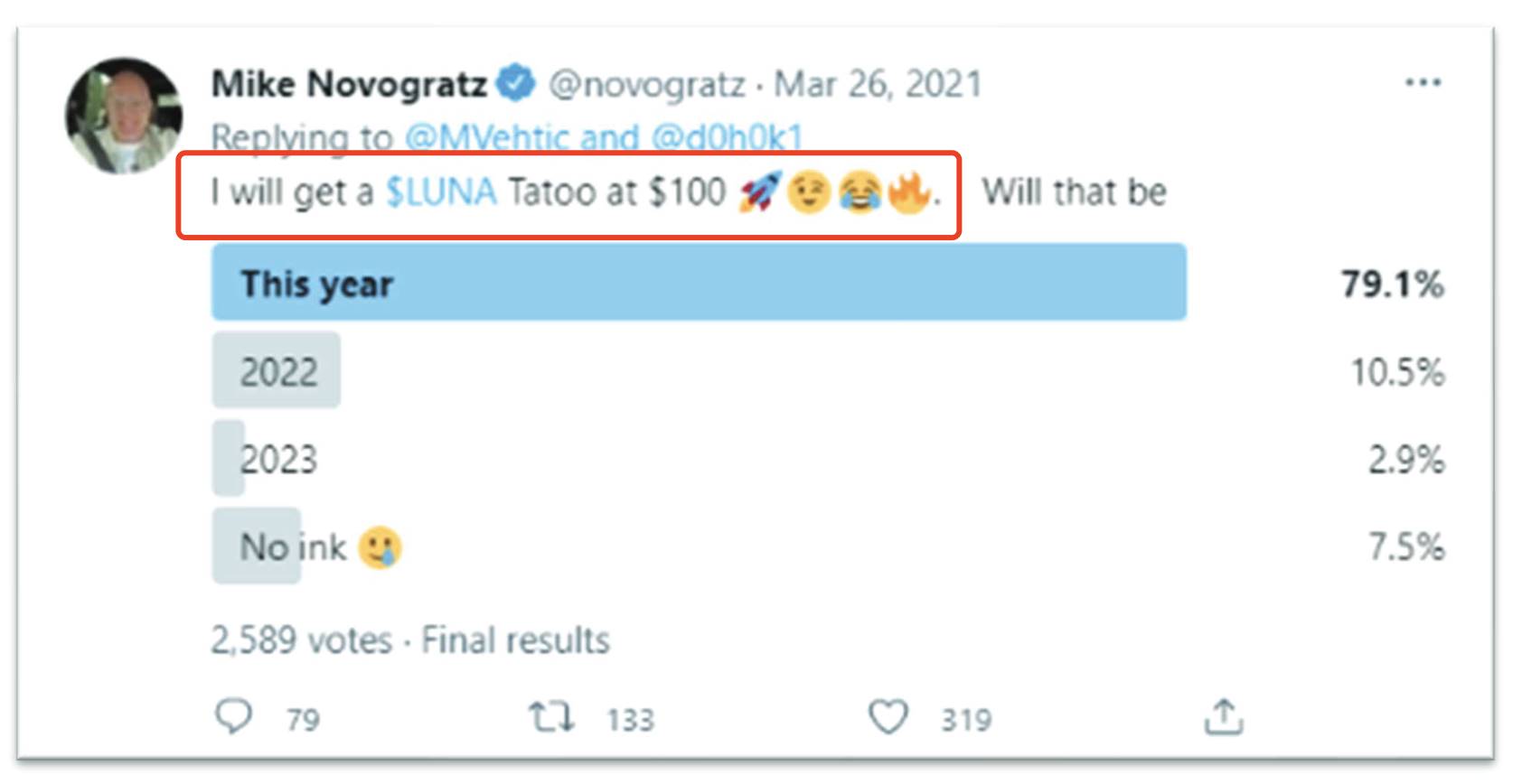
At the same time, Novogratz continues to confuse the relationship between Chai and Terra, making people mistakenly believe that the Terra blockchain has powerful real-world application scenarios. For example:
On April 26, 2021, Novogratz said in a podcast: 6% of payments in South Korea are already using Chai.
On May 21, he further exaggerated that 7%-8% of payments in South Korea are already conducted through blockchain-based Chai.
On June 22, he said again: 8% of payments in South Korea are made using Chai.
Speaking at the Barclays Global Financial Summit on September 13, he said that 9% of payments are now completed through the Luna blockchain.
However, Chai actually accounts for less than 1% of all transactions in South Korea, and Chai is not supported by the Terra blockchain, and has nothing to do with Luna. These data are completely false, but the effect is immediate. After each speech, the price of Luna has risen sharply, and Galaxy has taken the opportunity to sell chips without hesitation every time:
In early May 2021, 1.3 million Luna were sold at a maximum price of $18.60 per coin;
On June 4, nearly 1.79 million coins were sold at a price of about $6.91 per coin;
In early August, another 1.61 million coins were sold, with the price ranging from US$12.19 to US$14.79.
On December 24, 2021, Christmas Eve, Luna really rose to $100! Novogratz kept his promise and posted a photo of a Luna tattoo on his arm, which caused a frenzy across social media.
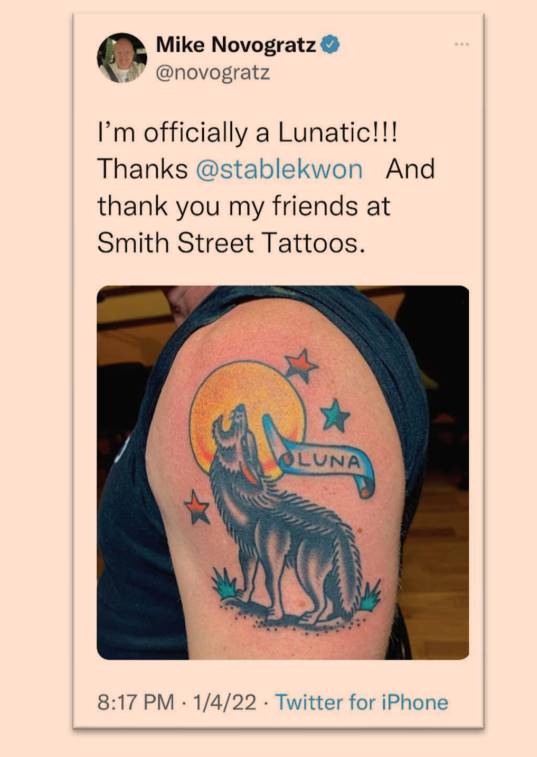
However, Galaxy, which was tattooing and shipping at the same time, had no intention of stopping. On Christmas Day, they began to sell Luna at $96.96. Thereafter, in early January 2022, Galaxy continued to sell a large number of units at a high price of around $90, cashing in tens of millions of dollars in total.
Can you imagine? When Novogratz posted that arm tattoo photo, the traders behind him were rapidly typing away on their keyboards, throwing Luna chips into the frenzy of the market.
2.4 The final madness: shouting "Keep the faith" while shipping in large quantities
At the beginning of the new year of 2022, Galaxy and Novogratz began their final madness.
On January 5, when Luna fell from a high of $100 to around $80 and market sentiment began to waver, Novogratz reappeared. He comforted anxious investors on Twitter: After a big rise, the market will always consolidate, and $100 is just a symbolic number. Be patient, Luna will definitely rise. Keep the faith!
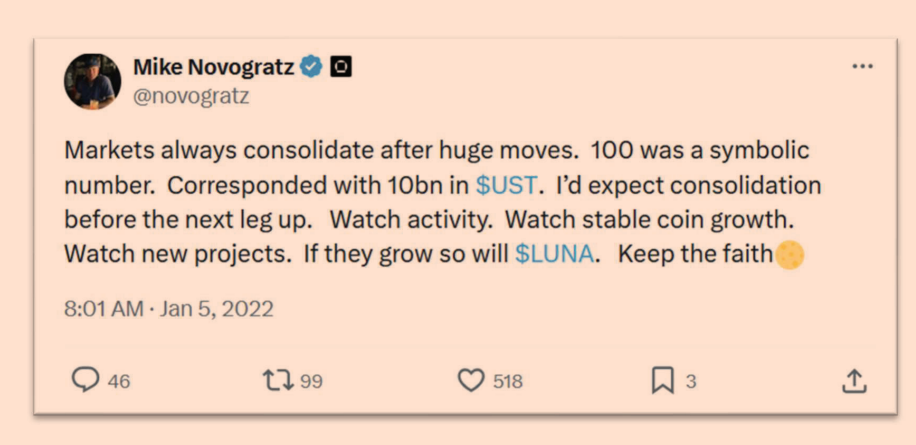
This famous phrase “Keep the faith” was like a shot of adrenaline, rekindling the hopes of tens of thousands of Luna holders. However, at the same time, a completely different scene was playing out in Galaxy’s trading room:
On January 5, Galaxy sold more than 160,000 Luna coins at a price range of $77.51-84.80, cashing out about $13.58 million on the same day;
In the following two days from January 6 to January 7, Galaxy once again sold more than 520,000 Luna without hesitation, with a total amount of nearly 40 million US dollars;
From January 10 to January 13, in just four days, Galaxy shipped nearly 680,000 Lunas in succession, cashing in more than $50 million again.
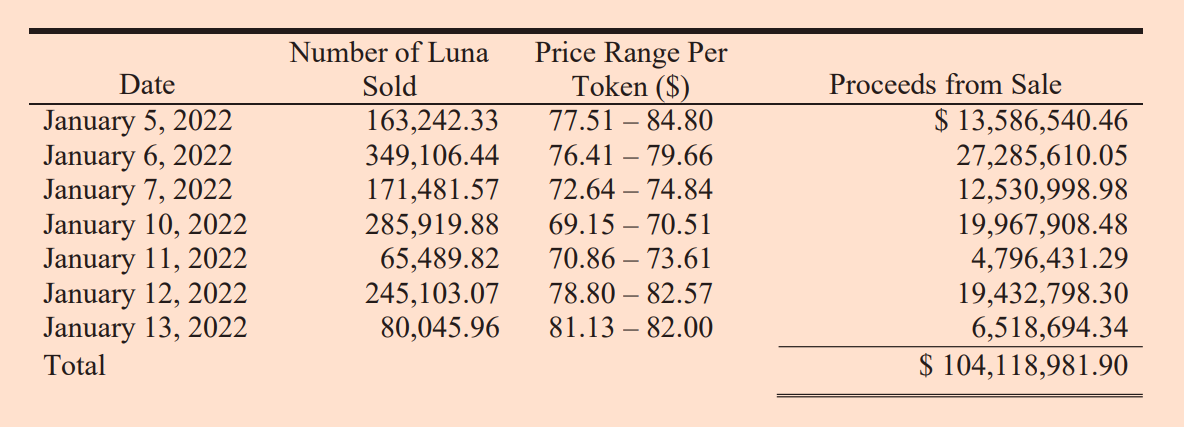
Amid Novogratz's enthusiastic "Keep the faith" voice, Galaxy has quietly sold more than 1.3 million Luna in just one week, with a cumulative cash out of $104 million! At the same time, they did not disclose any sales to the public, still maintaining their "faith-backed" persona.
An even more absurd scene occurred on January 15. When Luna fell to around $87, Novogratz once again humorously retweeted the picture of "Viejo Lobo" (Spanish for old wolf) on Twitter, joking that his position in the Luna community seemed to imply that he was an experienced old wolf, sitting firmly on the Diaoyutai.
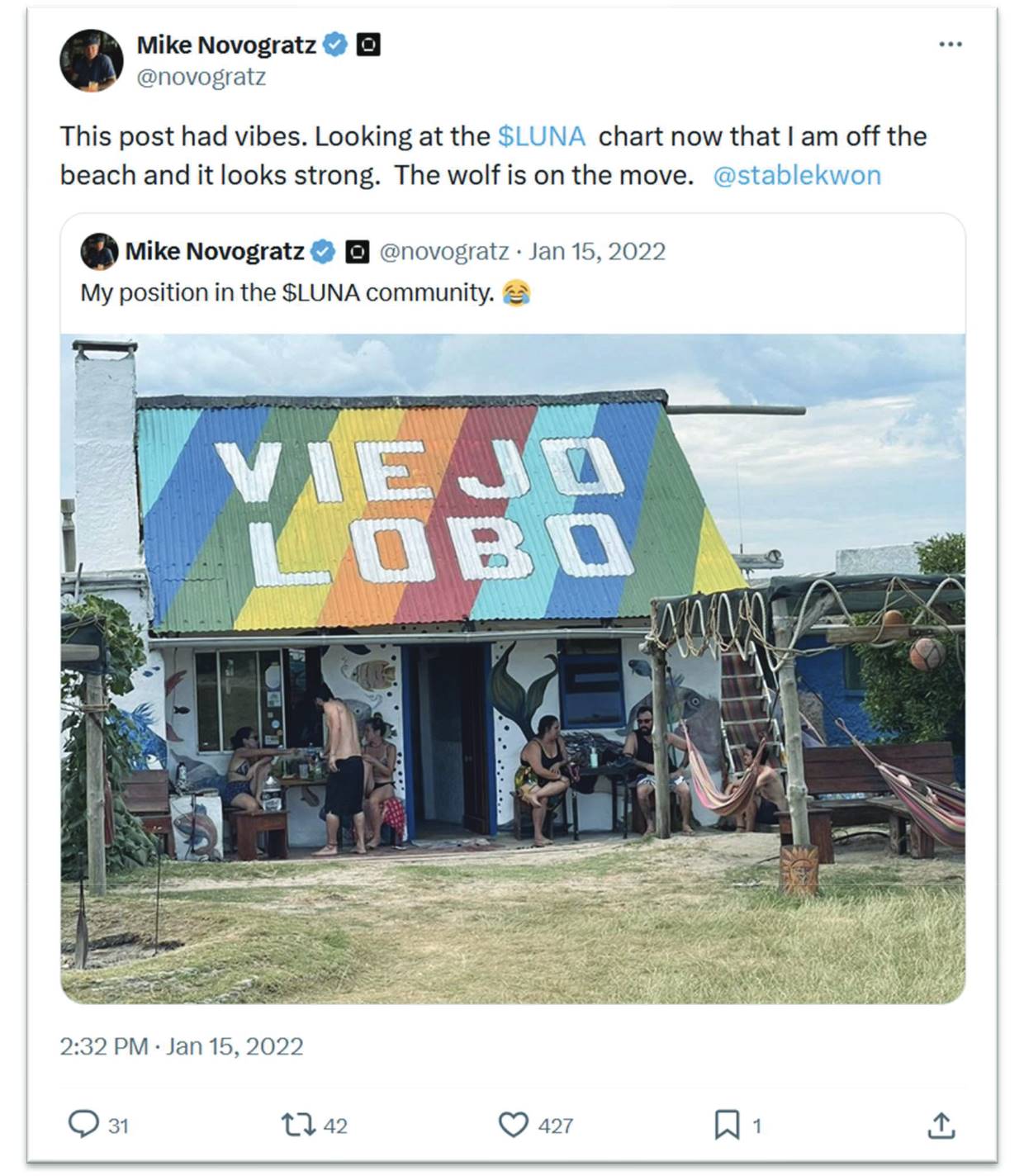
However, just within an hour and a half after the tweet, Galaxy quickly sold 13,276 Lunas, accurately capturing the short-term rebound and cashing out $1.15 million.
In the following week, Galaxy sold more than 1.1 million Lunas almost crazily, and the price continued to drop from US$69 to US$48.
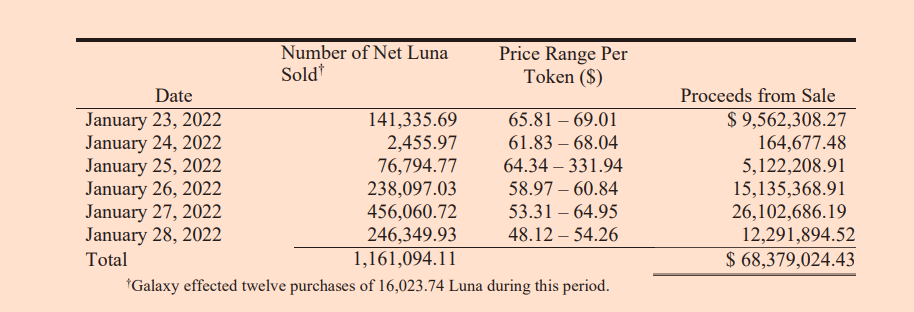
Despite this, Novogratz still shouted "Keep the faith" and encouraged followers to hold on as if this was just a normal market adjustment.
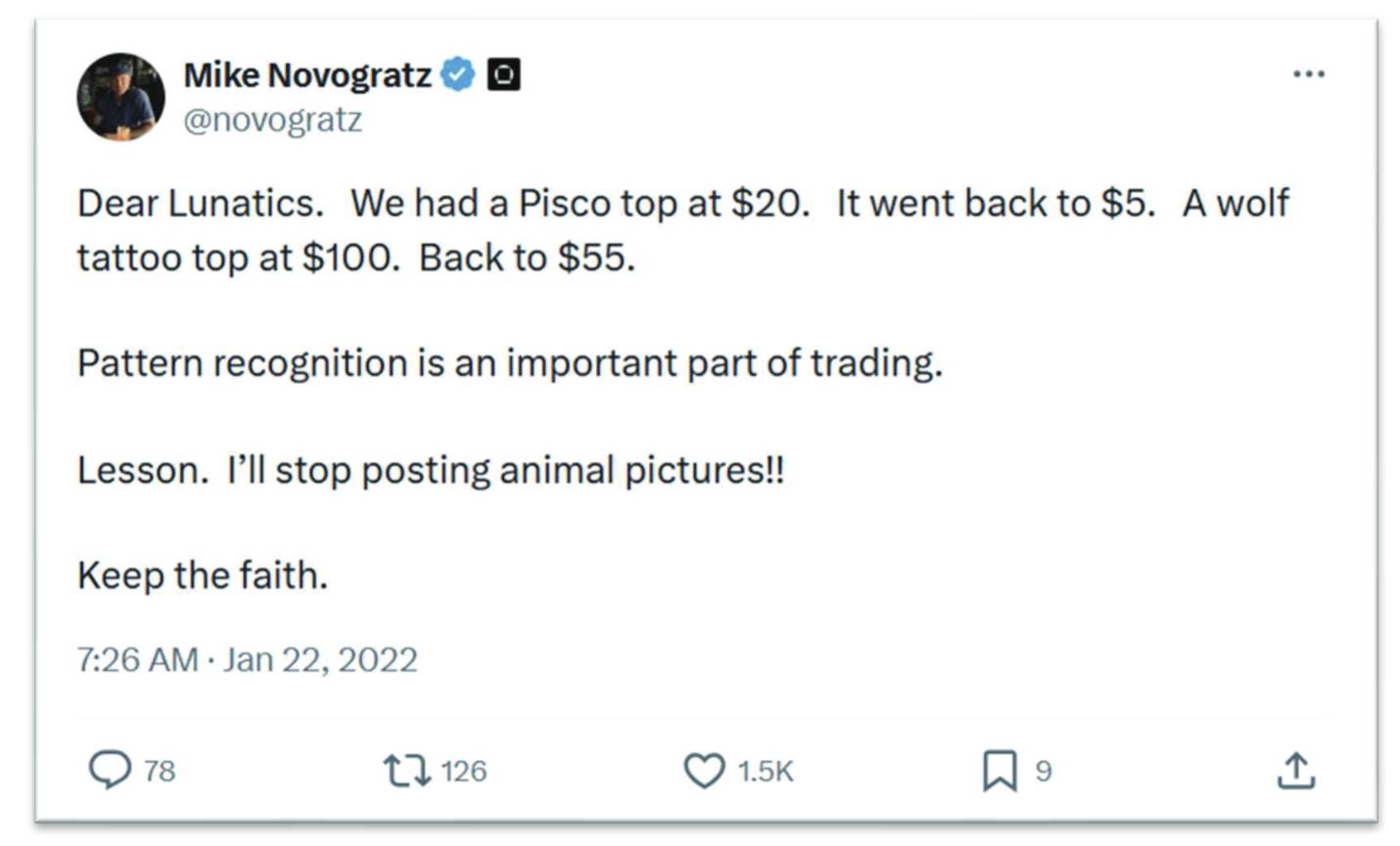
2.5 Summary: After the carnival, the ground is full of mess
Galaxy and Novogratz's final madness on Luna perfectly illustrates the art of institutional selling.
On the surface, they always act as loyal crypto evangelists, shouting "faith" inspiringly, and even tattooing the Luna totem on their arms.
However, behind the spotlight, they carefully planned and sold Luna on a large scale and continuously until their positions were almost cleared.
The end of this game is doomed. On May 9, 2022, when TerraUSD (UST) completely collapsed, it triggered Luna’s death spiral. Luna’s price plummeted from $65 to $0.004 in just three days, and its $40 billion market value was wiped out.
But by then, Galaxy had already left the market safely, leaving only 2,060 Lunas on the books, worth less than $10.
Next, it’s our turn to reflect.
3. Can you escape this scam?
After reading the ups and downs of Galaxy's pump and dump story, perhaps a pressing question has already arisen in your mind: If I had been smarter and more cautious, could I have avoided this scam?
To answer this question seriously, we must use an objective attitude, based on facts and data, to gradually dismantle the clues hidden behind this scam, and what advantages and disadvantages ordinary investors actually have. Next, we will conduct an in-depth analysis from the two dimensions of why it is possible and why it is not possible.
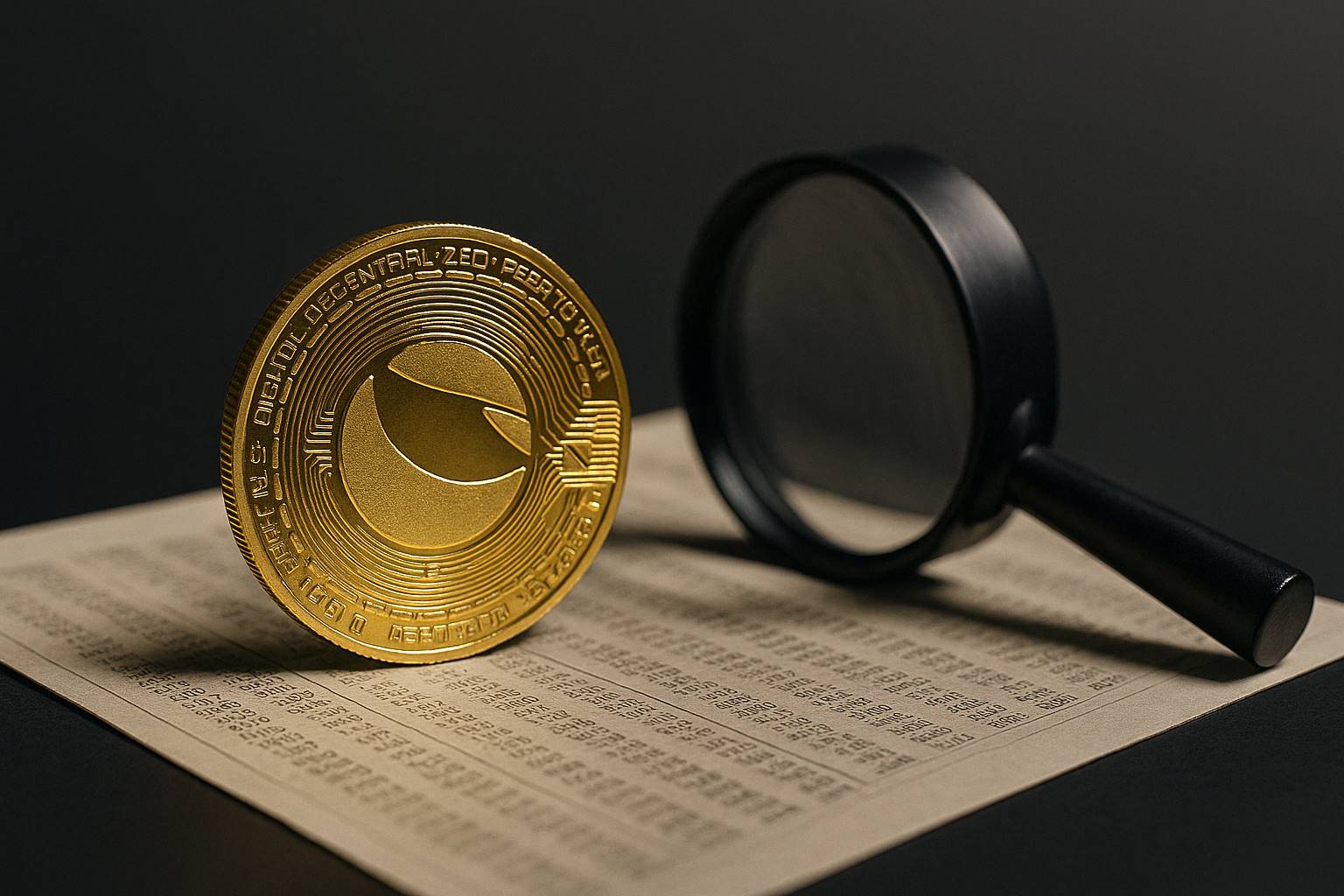
3.1 Why is it possible?
In fact, if you can remain vigilant enough and have enough common sense and patience, it is entirely possible to avoid Galaxy’s carefully woven "pump and dump" scam.
First, clues to exaggerated data
Careful investors, with just a little homework, can detect that the data used by Galaxy and Novogratz in their promotions are seriously exaggerated or even false.
For example, Novogratz repeatedly
In April 2021, 6% of payments in South Korea were already made through Chai.
On May 21, the figure became 7%-8%.
By September, Novogratz went so far as to claim that 9% of all payments in South Korea were being made using the Luna blockchain.
But what are the actual data? According to Chai's official data (which can be checked through channels such as Chaiscan), Chai's payment transaction volume has always accounted for less than 1% of the Korean payment market. And Chai has never actually used Terra's blockchain to settle transactions.
If you check the Chaiscan data, you will find that these so-called powerful application scenarios are castles in the air. In other words, if you pay a little attention, you can easily find that there are huge data deviations and misleading elements in Galaxy's publicity.
Second, there are obvious signs of long-term cashing out
Another important clue to identify a scam is the market performance after each public shill by Galaxy.
Let’s take December 3, 2020 as an example. When Novogratz announced on Twitter that Chai had 80,000 daily active users, Luna’s trading volume on that day quickly soared from US$27.5 million to US$69 million.
Just two weeks later, Galaxy quickly cleared out its first batch of Luna at a price of around $0.50, realizing quick cash out.
For example, on January 30, 2021, just a few days after Bloomberg reported that Galaxy invested in Luna, Galaxy quickly liquidated 1.54 million Luna again. This shipment time is very close to the publicity, and each time the price is immediately cashed out after it has just risen.
This regular shipment is repeated every month. As long as you pay a little attention to the on-chain data or Luna circulation, you can clearly see the signs of large investors reducing their positions regularly, and thus infer that the traders behind them may have the intention of structured shipment.
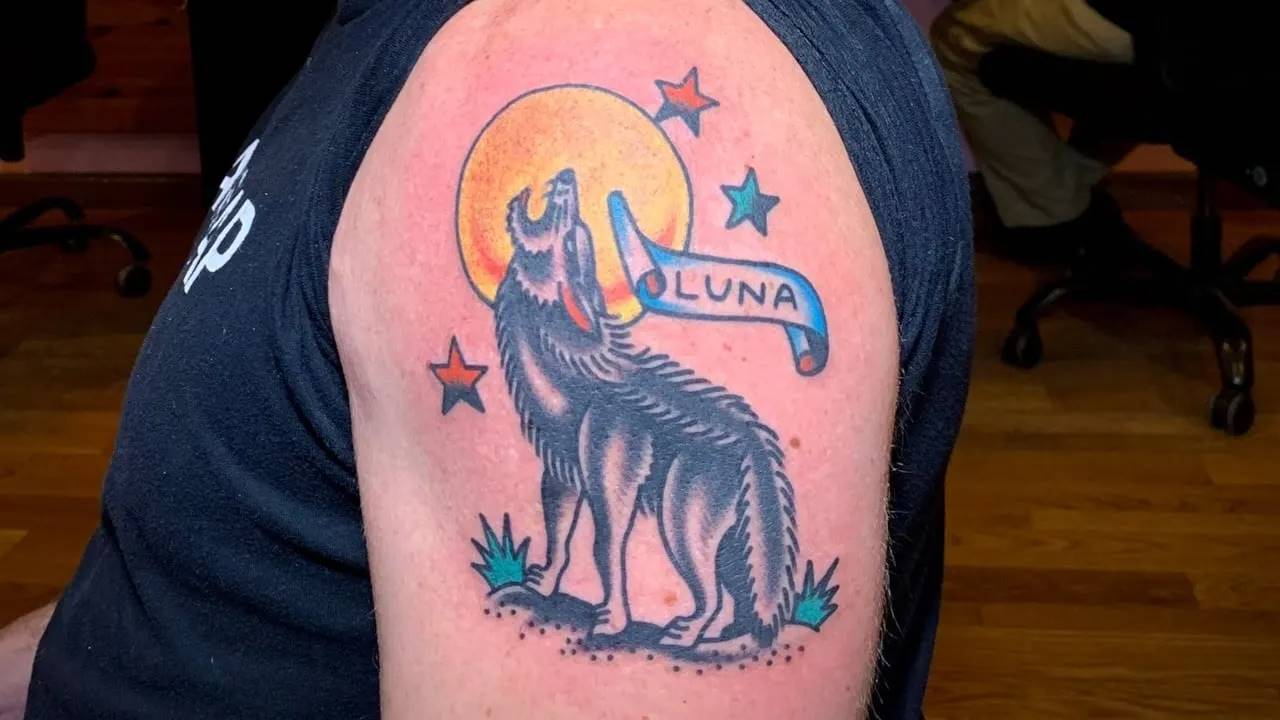
Third, overly exaggerated personal endorsements
A third sign that can help you avoid a scam is Novogratz’s obviously exaggerated personal endorsement.
Novogratz said: If Luna reaches $100, he will get a tattoo of Luna! This kind of personal commitment can certainly boost emotions, but it is also too exaggerated and obvious, which exposes the motivation of the manipulator to urgently boost market sentiment.
Truly professional investors and institutional investors usually do not make such clear market commitments in public. When the market sees such dramatic commitments or overly extreme shill, prudent investors should be vigilant and avoid blindly following the trend.
3.2 Why not?
However, in addition to rational analysis, we must also admit that for the vast majority of ordinary investors, it is extremely difficult, or even almost impossible, to avoid high-level, structured scams like Galaxy.
First, the authority of the institution is too strong.
Galaxy Digital CEO Mike Novogratz is a legendary figure in the crypto market. He was a partner at Goldman Sachs and has long appeared on top financial media such as CNBC and Bloomberg. In addition, his successful experience in investing in Bitcoin and Ethereum in his early years has established a high level of authority and credibility.
For ordinary investors, seeing an "industry expert" who once accurately predicted market trends personally come out to recommend a project can easily form a strong psychological anchoring effect, causing them to quickly relax their vigilance and rely entirely on the expert's recommendations to make decisions, while giving up independent thinking.
Galaxy precisely exploited this authority effect to successfully manipulate market sentiment. For most investors, it is extremely difficult to discern the hidden motives behind this authority.
Second, sophisticated media operations and public relations strategies
When promoting Luna, Galaxy cooperated with many top media (such as Bloomberg and CoinTelegraph) to successfully create a market impression that Luna seems real and credible.
A Bloomberg report on January 26, 2021 clearly showed that Galaxy directly provided false data to Bloomberg, exaggerating the powerful ecology and real-world application scenarios of Terra and Luna, and creating the illusion of an explosive market rise.
This kind of precise manipulation in the media makes it difficult for ordinary investors to have doubts. After all, when ordinary people see positive reports on a project in the mainstream media, they naturally tend to think that this is objective and reliable information that has been investigated by the media, and it is extremely difficult to think that this is a carefully designed manipulation of public opinion.
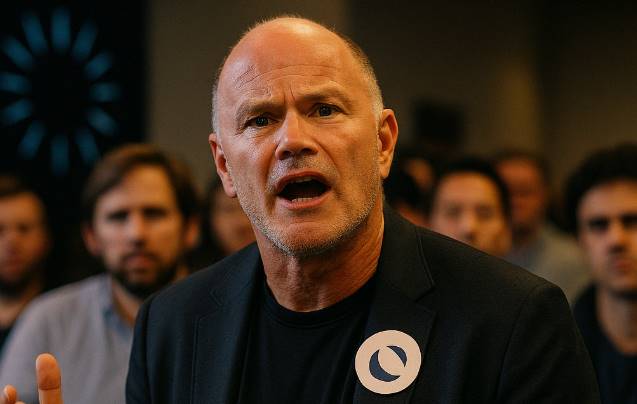
Third, the emotional manipulation of Keep the faith
From a psychological perspective, Novogratz's "Keep the faith" slogan is extremely effective in manipulating investors' emotions. When the market is falling, what ordinary investors want to hear most is someone encouraging them to keep their faith and not give up easily.
This kind of emotional guidance is more penetrating than any rational analysis. Novogratz is good at using this emotion to firmly control market sentiment with his infectious rhetoric, making investors still reluctant to sell when the market falls, and even continue to increase their positions at low levels, becoming the leeks who take over.
In fact, it is almost impossible for ordinary investors to stay fully awake when Galaxy is frantically selling from high positions. Because when everyone shouts their faith, skeptics will be regarded as outliers and suffer tremendous psychological pressure.
3.3 Summary: The trade-off between what you can and cannot do
Back to our original question: Can you escape this scam?
Objectively speaking, it depends on how much market knowledge, investment experience and independent thinking ability you have.
If you are careful enough, can keenly perceive the difference between data and reality, can discover the abnormal cash-out patterns after each shill, and can be vigilant against dramatic publicity, it is entirely possible for you to detect the scam in advance.
But if you are just an ordinary investor, confused by the halo of institutional authority, misled by the media's elaborate packaging, and infected by emotional slogans, then most people will hardly be immune to Galaxy's carefully designed script.
Greed and deception will always exist in the market. Galaxy’s story is not the first and will definitely not be the last.
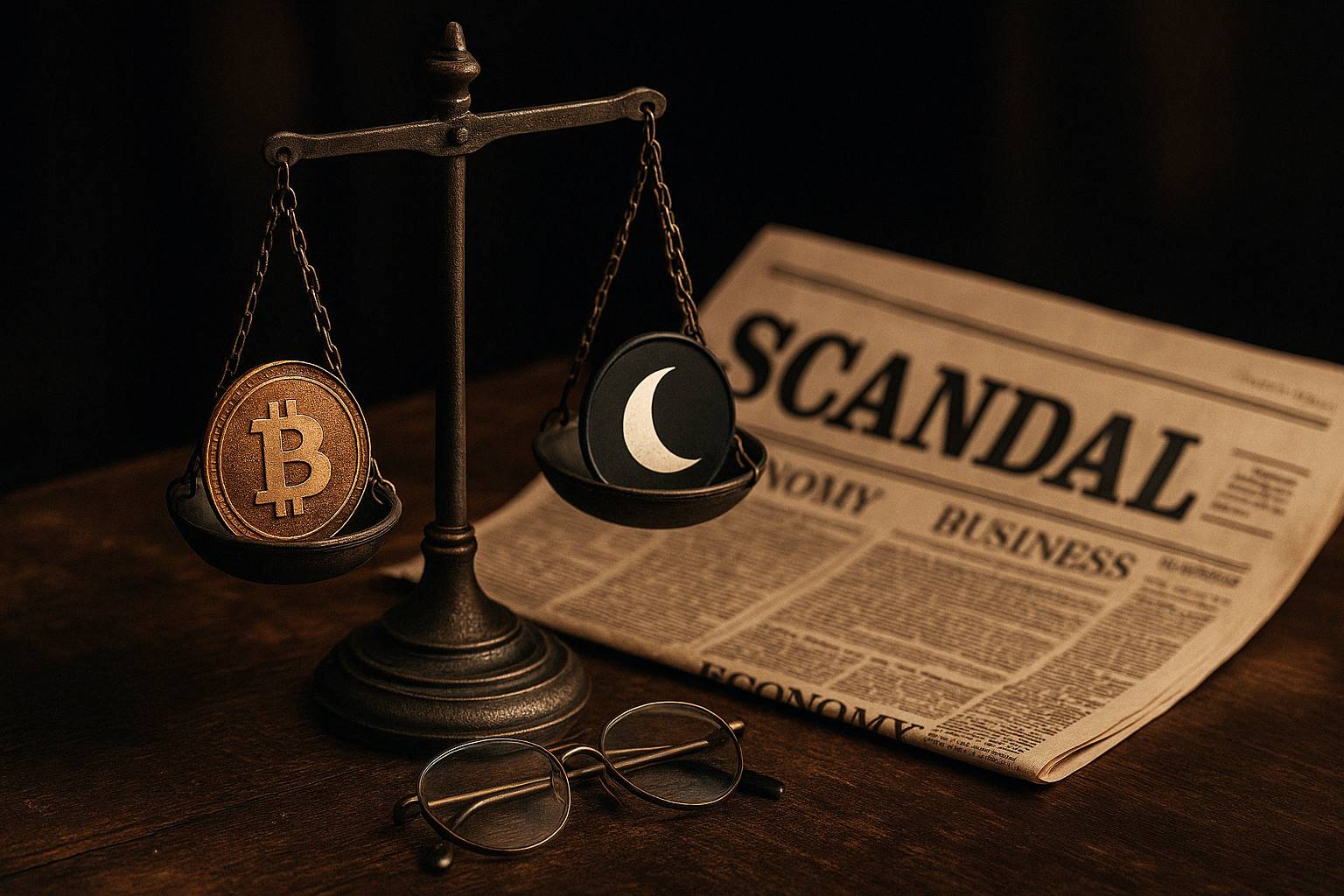
Conclusion
The line of trust between preaching and harvesting, once crossed, becomes the edge of a sickle. Behind every scam is a game of human greed and fear.
In the story of Galaxy and Luna, we see how authority becomes a tool for harvesting, how the media becomes a megaphone for scams, and how emotions become fuel for greed. But in the final analysis, there is no free wealth in this world, and no sudden wealth without reason.
Faith is originally the most moving word in the investment world, but when it is used by people with ulterior motives to manipulate the market, faith becomes poison and will eventually backfire on every blind follower.
However, we must also admit that Galaxy is not a mere predator. They bravely stood at the forefront of the crypto market when it was still in its wild days, injecting capital and confidence into the industry. Novogratz's foresight and Galaxy's contribution to the standardization of the industry have indeed pushed the crypto world into the mainstream. They have accompanied the industry through ups and downs, witnessed and promoted the change of an era and the rise of the industry. Unfortunately, when the temptation of capital collided with the bottom line of morality, Galaxy failed to stick to its original intention and chose a less glorious shortcut.
A true investor must understand that investment does not rely on authoritative guidance, nor on media hype, but on one's own independent thinking and rational judgment.
Because: every time you blindly follow others, you are paying for the scam; and every time you question, you are accumulating capital for freedom.
From today on, remember:
Don’t be superstitious about authority, trust data;
Don’t follow blindly, think independently;
Don't be carried away by emotions, control them with reason.
After all, the market is never kind, and only those who truly stay sober deserve true financial freedom.
Finally, we should thank the Martin Act. We hope that under the powerful deterrent of the Martin Act, KOLs will no longer be so unscrupulous in pumping up shipments.




